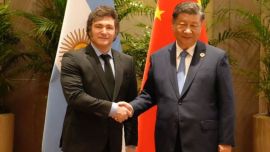Brazil’s Central Bank kept its key interest rate unchanged and expressed concern about the costs of taming rising inflation expectations that have been fuelled by tensions with President Luiz Inácio Lula da Silva’s new government.
Policymakers held the benchmark Selic at 13.75 percent for the fourth straight meeting late on Wednesday, in line with investor consensus. In a statement widely considered to be hawkish, board members wrote they will assess if keeping rates steady “for a longer period” than previously expected will slow inflation to target.
“The current scenario, particularly uncertain on the fiscal side and with inflation expectations drifting away from the inflation target on longer horizons, requires further attention when evaluating risks,” they wrote. “The Committee judges that this scenario raises the cost of the disinflation that is needed to reach the targets” established for the years ahead.
Policymakers led by Roberto Campos Neto are battling rising cost-of-living expectations that make it more difficult to justify rate cuts, even as annual inflation has consistently eased over the past few months — to 5.87 percent, from last year’s peak of more than 12 percent. The decline has been driven by tax cuts and restrictive borrowing costs, but fuel prices are now going up while core measures that strip out the most volatile items are accelerating.
“Officials referred to the strategy of holding rates for longer than what’s assumed in its forecasts, i.e. consensus projections. We think that’s an attempt to sound hawkish without suggesting a rate hike. Currently, the consensus forecast is for the first rate cut to come in September. The statement language suggests it may come later," said Adriana Dupita, Bloomberg's economist for Brazil and Argentina.
The decision comes amid high political tensions, as Lula has questioned the Central Bank’s independence and its inflation goals, suggesting it should pursue a 4.5 percent target. Currently, the bank targets price increases of 3.25 percent for 2023 and 3 percent for the next two years.
Finance Minister Fernando Haddad added to speculation that policies may change, saying that Brazil needs ambitious, yet feasible targets.
Investors are also fretting about the fiscal outlook, as Haddad is expected to propose new spending rules by April, replacing the current law that limits public expenditure increases to the prior year’s inflation rate. The new government is also deploying 168 billion reais (US$33 billion) in additional spending, including social aid, while weighing a higher minimum wage.
“The statement is hawkish,” said Felipe Sichel, economist and partner at Modal Asset Management Ltda. “It leaves the door open to keeping rates steady for a longer period and clearly warns about worsening inflation expectations.”
Sichel added that he sees no borrowing-cost cuts this year.
Extremely harsh
In the statement, board members wrote that expectations for consumer price increases “have shown deterioration at longer horizons.” Meanwhile, the global economy remains under inflationary pressure despite positive signs at the margin, they wrote.
Earlier on Wednesday, the Federal Reserve slowed the pace of rate rises but said more increases are in store. Regionally, policymakers from Mexico to Colombia continue to hike, while Chile’s central bank President Rosanna Costa has pushed back against investor bets of the start of an easing cycle.
In an outlook considering rate cuts starting in September as shown in its weekly economist survey, Brazil’s Central Bank sees consumer price increases above the ceiling of its tolerance range in 2023 and above target next year. In an alternative scenario with a constant Selic, inflation forecasts stand lower, at 5.5 percent for this year and 2.8 percent for next.
In the outlook with steady borrowing costs, “inflation is closer to the three percent target in 2024,” said Leonardo Costa, an economist at Asa Investments. “That indicates the central bank’s plan is to keep rates steady for a longer period.”
Meanwhile, analysts see consumer prices rising above the bank’s mid-term goal for the foreseeable future. Officials will set the 2026 target this year.
“The statement was extremely harsh,” said Carla Argenta, chief economist at CM Capital. “The Central Bank understands that, under current conditions, we don’t have inflationary convergence, and that the institution should make some change in its monetary policy or keep rates steady for longer.”
related news
by Maria Eloisa Capurro, Bloomberg























Comments